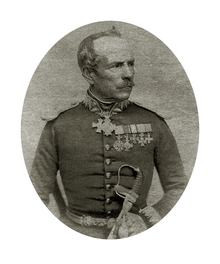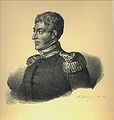Karl Krazeisen
Karl August Krazeisen , since 1858 Knight von Krazeisen (often also Kratzeisen ; * October 27, 1794 in Kastellaun , † January 25, 1878 in Munich ) was a Bavarian infantry officer and hobby painter who portrayed the leaders of the Greek freedom struggles in Greece and later rose to general .
Life
family
He was born as the son of the legation councilor of the same name of the ducal Zweibrücken. Krazeisen was married to Franziska Lindauer for the first time. After her death in 1849, he married Maria Leonhard a year later. Their son Carl Johann von Krazeisen (1851–1924) worked as a lawyer and president of the Bavarian Administrative Court .
Military career
Krazeisen resigned after his training in the Cadet Corps in 1812 as a second lieutenant in the 1st Line Infantry Regiment of the Bavarian army one. In 1813/14 he took part in the wars of liberation against Napoleonic rule. In 1826 he went to Greece as a first lieutenant with other officers on Bavarian wages to train Greek troops and thus support the Greek liberation struggle , which - after the military successes of the Ottomans and before the intervention of the major European powers - was in a critical phase. The action, the cost of which was borne by a committee of Philhellenes supported by the Bavarian King Ludwig I , turned out to be unfeasible. However, Krazeisen is said to have also participated in the historic attack on Athens on March 6, 1827 and in the battles for the Acropolis on April 22, 1827 under the command of Charles Nicolas Fabvier .
After returning to Munich, Krazeisen was initially convicted of desertion, but was later rehabilitated. He was promoted to major general and brigadier (chief) of the then 4th Bavarian Army Brigade in Speyer . Thus he was the highest ranking Bavarian soldier in the Rheinpfalz . As such, he received the Knight's Cross of the Order of Merit of the Bavarian Crown from King Maximilian II on June 20, 1858 and was raised to the personal nobility status on August 24 of that year and was allowed to call himself "Knight of Krazeisen" after entry in the nobility register . In 1861 he was awarded the Commander's Cross of the Order of Merit of St. Michael .
Greece honored him with the Order of the Redeemer .
After his promotion to lieutenant general in 1863 he was appointed governor of the fortress Germersheim . Krazeisen also acted as President of the General Auditorium in Munich. In 1874 he was awarded the character as General of Infantry to the disposition provided.
Artistic work
From 1817, Krazeisen attended the Munich Art Academy as a first lieutenant , where he learned history painting. He used his stay in Greece, with a feeling for historical significance, to draw portraits of famous personalities of the liberation struggle as well as landscapes and Greek costumes. Krazeisen returned to Munich in 1827 and had his Greek drawings largely converted into lithographs by Franz Hanfstaengl and Peter von Hess . His album "Portraits of excellent Greeks and Philhellenes, together with some views and costumes" was printed in seven editions between 1828 and 1831. The dissemination of these portraits of the heroes of the Greek liberation struggle represented a significant support for philhellenism in Europe. Since Krazeisen had portrayed all the leaders of the revolution who were living at the time of his stay in Greece, his album represents the most comprehensive collection with which these personalities are passed on to posterity were. He was the only one who made his drawings of the Greek national heroes during their lifetime.
Georgios Mavromichalis
literature
- Jürgen Kraus : The Bavarian Army 1822. German Society for Heereskunde . Ingolstadt 2011, DNB 1011140020 , pp. 5-7.
- Hajo Knebel : Eberhard Kieser, Karl Krazeisen, Eduard Bäumer. Three artists from Kastellaun in art history. In: Hunsrücker Heimatblätter. 1989, pp. 338-341.
- Georg Kaspar Nagler : New general artist lexicon. Volume 7: Keyser. – Lodewyck. Fleischmann, Munich 1839, pp. 168–169 ( digitized in the Google book search).
- Karl Krazeisen . In: Hans Vollmer (Hrsg.): General lexicon of fine artists from antiquity to the present . Founded by Ulrich Thieme and Felix Becker . tape 21 : Knip – Kruger . EA Seemann, Leipzig 1927, p. 476 .
Web links
- Information on the website of the Greek Parliament ( Memento of March 8, 2005 in the Internet Archive )
- Kathimerini from January 2nd, 2006: “Greek heroes' images recorded”
- Ethnos-online from October 14, 2008: The photographer of the heroes of '21. (Greek)
- Argolikos Archival Library of History and Culture: Krazeisen Karl (1794–1878). The painter of the fighters from '21. (Greek)
Individual evidence
- ↑ On the gravestone is October 27, 1794. According to other information, he was born on October 25, 1794 in Zweibrücken ( Georg Kaspar Nagler : Neues Allgemeine Künstler-Lexicon 1839. S. 168 books.google.de .).
- ↑ Krazeisen, Karl . In: Hans Vollmer (Hrsg.): General lexicon of fine artists from antiquity to the present . Founded by Ulrich Thieme and Felix Becker . tape 21 : Knip – Kruger . EA Seemann, Leipzig 1927, p. 476 .
- ^ Eduard Maria Oettinger: Moniteur des Dates contenant un million de renseignements biographiques, généalogiques et historiques. Supplément, Volume 9, 1882, p. 102 ( digitized in the Google book search).
- ↑ Walter Schärl: Munich Historical Studies: Department Bavarian history. Volume 1. Munich 1955, p. 221 ( limited preview in the Google book search).
- ^ Berthold Seewald: Karl Wilhelm von Heideck. A Bavarian general in liberated Greece (1826–1835) . Oldenbourg, Munich 1994, ISBN 3-486-59428-1 , p. 46 ( books.google.de ).
- ↑ a b Kathimerini of January 2, 2006: “Greek heroes' images recorded”
- ^ Official Journal of the Palatinate. No. 55. Speyer. July 17, 1858.
- ^ Official Journal of the Palatinate. No. 3. Speyer. January 18, 1859.
- ↑ Augsburger Allgemeine Zeitung. (Supplement) No. 60 of March 1, 1861, p. 978 ( digitized in the Google book search).
- ↑ Register entry at the Munich Art Academy.
- ↑ Brigitte Salmern: Johann Michael Wittmer (1802-1880). Studies of life and work. Dissertation University of Passau, 2006, p. 130 ( urn : nbn: de: bvb: 739-opus-1004 ).
| personal data | |
|---|---|
| SURNAME | Krazeisen, Karl |
| ALTERNATIVE NAMES | Krazeisen, Karl August (full name); Krazeisen, Karl Ritter von; Scraper, Karl |
| BRIEF DESCRIPTION | Bavarian officer and painter |
| DATE OF BIRTH | October 27, 1794 |
| PLACE OF BIRTH | Kastellaun |
| DATE OF DEATH | January 25, 1878 |
| Place of death | Munich |
















